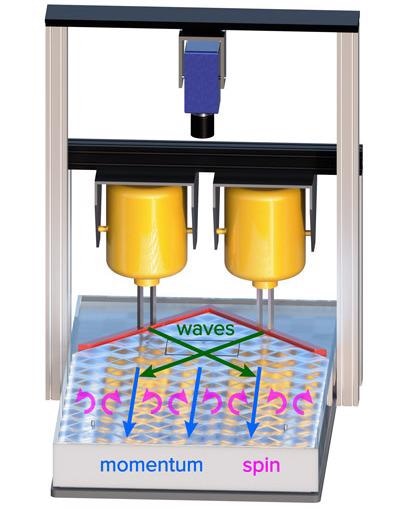RIKEN physicists have demonstrated that water waves may be utilized to represent key notions in relativistic field theory, such as spin angular momentum. This will aid in the discovery of new information about a variety of wave systems.
 Figure 1: Researchers at RIKEN have used water waves to generate small circulations of water particles (pink arrows) that generate spin angular momentum of water waves, a classical counterpart of the spin of quantum wave fields. Image Credit: © Reprinted with permission of AAAS from Ref. 1. © K. Y. Bliokh et al., some rights reserved; exclusive licensee AAAS. Distributed under a CC BY-NC 4.0 License.
Figure 1: Researchers at RIKEN have used water waves to generate small circulations of water particles (pink arrows) that generate spin angular momentum of water waves, a classical counterpart of the spin of quantum wave fields. Image Credit: © Reprinted with permission of AAAS from Ref. 1. © K. Y. Bliokh et al., some rights reserved; exclusive licensee AAAS. Distributed under a CC BY-NC 4.0 License.
The idea of spin angular momentum, or spin, was first established about a century ago and is crucial in quantum physics. It also supports the developing fields of spintronic and quantum computing. The spin of an electron is commonly described in basic physics as the electron spinning on its axis, equivalent to a spinning top. However, a more detailed description of spin is conceptual and does not lend itself to simple illustrations.
Konstantin Bliokh of the RIKEN Theoretical Quantum Physics Laboratory and colleagues have now demonstrated that spin can arise in water waves as tiny circular movements of water particles (Figure 1).
We were surprised that our collaborators from the Australian National University were able to observe this effect in experiments so readily. Similar phenomena in optics and acoustics tend to be too tiny to observe, but with water waves, everything is a few millimeters in size and you can observe it with your eyes. That’s the beauty of this experiment.
Konstantin Bliokh, Theoretical Quantum Physics Laboratory, RIKEN
It was particularly surprising since the idea of spin is derived from relativistic field theory mathematics and therefore does not relate directly to water waves. However, the scientists were able to prove that water waves and formal theory for spin angular momentum have a mathematical link. Diverse events that appear to be completely unconnected can be linked by common mathematics, which is often the case in physics.
It’s nice to gain a unified picture of different wave systems and see the parallels between them. This approach illuminates the physics behind different phenomena and could be very fruitful for the future development of different fields.
Konstantin Bliokh, Theoretical Quantum Physics Laboratory, RIKEN
He points out that information might flow both ways and that the relationship could teach us more about fluid dynamics.
The example, according to Bliokh, could also be useful in teaching quantum field theory.
Quantities like spin density are derived in a very abstract way. It appears in some equations, but you observe totally different things in experiments. For the first time, we have directly observed spin density in water waves. So it’s really a platform for visualizing properties that are hidden in quantum field theory.
Konstantin Bliokh, Theoretical Quantum Physics Laboratory, RIKEN
The researchers are currently looking into how field theory may be utilized to learn more about different types of classical waves.
Journal Reference:
Bliokh, K. Y., et al. (2022) Field theory spin and momentum in water waves. Science Advances. doi.org/10.1126/sciadv.abm1295.